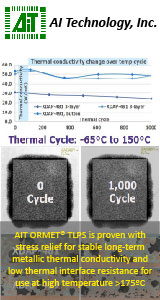|

|
|
| Ask the Experts | |||||||
|
|||||||
|
July 24, 2024 - Updated July 5, 2007 - Originally Posted Coating to stop tin whisker growth?Is there a conformal coating that will stop tin whisker growth? D.H. |
|||||||
| Expert Panel Responses | |||||||
|
There is no conformal coating known to stop tin whisker growth.
R&D Director Cookson Electronics, Enthone Ms. Zhang has a PhD in chemistry/electrochemistry. Experiences include AT&T/Lucent Bell Labs, Technic, Cookson Electronics/Enthone. Areas of expertise include: electroplating; Sn whiskers, wafer bumping, Cu post/pillar, Cu redistribution lines and Sn and SnAg bumps.
No, tin whisker growth cannot be stopped with conformal coating. Conformal coating if properly applied will prevent the electrical shorts associated with tin whiskers on the circuit boards.
Regional Sales Manager OK International Inc. Ed Zamborsky is a Regional Sales & Technical Support Manager for Thermaltronics, located in New York. His position requires frequent customer visits throughout North America and the Caribbean and his position encompasses not only sales but the role of trainer and master applications engineer for all of Thermaltronics products. His expertise includes such specialties as hand soldering, convection and conduction reflow techniques, array rework, fluid dispensing equipment, and fume extraction. Ed has authored many articles and has presented many papers on topics such as; Low Volume SMT Assembly, Solder Fume Extraction, SMT Rework, BGA Rework, Lead-Free Hand Soldering, High Thermal Demand Hand Soldering, Lead Free Visual Inspection and Lead Free Array Rework.
Opinions are somewhat mixed, but the general consensus is that some conformal coatings help mitigate tin whisker formation, whilst other coatings have no effect. It seems to be due to the hardness of the coating - the harder the coating, the better it stops tin whisker propagation (probably due to the force required to penetrate the harder coating). There was an excellent paper published about this very subject by Mr. Thomas Woodrow of Boeing. I have a copy but its 15Mb. If you search the web for Thomas Woodrow, Boeing, Tin Whiskers you'll pretty much find everything you want to know. I hope of some assistance.
Global Business Director conformal coatings division Electrolube Phil Kinner - Electrolube - Global Business Director conformal coatings division.
There is no conformal coating that will stop a tin whisker from emanating from a tin-plated surface. However, it has been theorized that once the whisker reaches a certain length it will most likely buckle before it punctures the conformal coating on the adjacent lead. Dr. Henning Leidecker has a paper that discusses the calculations in detail.
CEO & Managing Partner DfR Solutions Dr. Hillman's specialties include best practices in Design for Reliability, strategies for transitioning to Pb-free, supplier qualification, passive component technology and printed board failure mechanisms.
Since the announcement of the EU legislation on RoHS and the move of electronics manufactures to a Pb-free process there has been much concern regarding tin whisker growth on Sn-plated components. Since Sn-plated components are expected to be the primary plating finish many manufacturers (especially those that manufacture high-reliability devices) are concerned about the long term implications of using Sn-plated components. There have been a few studies that discuss the benefits of minimizing the impact of Sn-whiskers using a coating (H. Leidecker, and J. Kadesch, "Effects of Uralane Conformal Coating on Tin Whisker Growth", Proceedings of IMAPS Nordic, The 37th IMAPS Nordic Annual Conference, pp. 108-116, September, 10-13, 2000 and Thomas A. Woodrow and Eugene A. Ledbury, "Evaluation of Conformal Coatings as a Tin Whisker Mitigation Strategy", IPC/JEDEC 8th International Conference on Lead-Free Electronic Components and Assemblies, San Jose, CA, April 18-20, 2005) In the Boeing paper by Woodrow and co-authors they found that Parylene C and Silicones were the most effective at suppressing whisker growth and acrylics were the least effective. Once whiskers did begin to grow, all of the thinner coatings (approx. 1 mil) were penetrated (except the UR/AR Coating) and none of the thicker coatings (3.9 to 6.0 mils) were penetrated. So coatings can be a mitigation technique, if the correct material is applied as a thick layer. In order to be sure you have the protection required testing should be done on your parts and components.
Application Engineering Henkel Electronics Dr. Brian Toleno is the Application Engineering Team leader for Henkel Technologies. He is responsible for the technical service and application engineering for Henkel's electronics assembly materials, including solder paste, underfills, PCB protection materials, and underfills.
|
|||||||
| Submit A Comment | |||||||
|
Comments are reviewed prior to posting. You must include your full name to have your comments posted. We will not post your email address. |
|
Free Newsletter Subscription
Circuitnet is built for professionals who bear the responsibility of looking ahead, imagining the future, and preparing for it. Insert Your Email Address |
|

|







